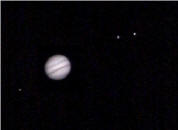|

www.AstroMax.com
Up
Abstract
I. Purpose
II. Background
III. Orbits
IV. Period Determination
V. Methods
VI. Kepler's Laws
VII. Observing Suggestions
VIII. Data Gathering
IX. Data Processing
X. Observer's Data Results
XI. Other Quad-A Results
XII. Conclusions
XIII. Attachments

This Project Jupiter Report
was prepared by
Mizar Consulting
Eugene A. Lanning
130 Hillside Terrace
Nebraska City, NE
68410-3740
ealanni@alltel.net
Member of AAAA
AAAA
The American Association
of Amateur Astronomers
P.O. Box 7981
Dallas, TX
75209-0981
e-Mail:
aaaa@astromax.com
www.AstroMax.com
| |
 Project Jupiter Project Jupiter
 
II. Background
A. Who first observed
 Probably
the most significant contribution that Galileo Galilei made to science
was the discovery of the four satellites around Jupiter that are now
named in his honor. Galileo first observed the moons of Jupiter on
January 7, 1610, through a homemade telescope. He originally thought he
saw three stars near Jupiter, strung out in a line through the planet (2)
. The next evening, these stars seemed
to have moved the wrong way, which caught his attention. Galileo
continued to observe the stars and Jupiter for the next week. On January
11, a fourth star (which would later turn out to be Ganymede) appeared.
After a week, Galileo had observed that the four stars never left the
vicinity of Jupiter and appeared to be carried along with the planet,
and that they changed their position with respect to each other and
Jupiter. Finally, Galileo determined that what he was observing were not
stars, but planetary bodies that were in orbit around Jupiter. This
discovery provided evidence in support of the Copernican system and
showed that everything did not revolve around the Earth.(3) Probably
the most significant contribution that Galileo Galilei made to science
was the discovery of the four satellites around Jupiter that are now
named in his honor. Galileo first observed the moons of Jupiter on
January 7, 1610, through a homemade telescope. He originally thought he
saw three stars near Jupiter, strung out in a line through the planet (2)
. The next evening, these stars seemed
to have moved the wrong way, which caught his attention. Galileo
continued to observe the stars and Jupiter for the next week. On January
11, a fourth star (which would later turn out to be Ganymede) appeared.
After a week, Galileo had observed that the four stars never left the
vicinity of Jupiter and appeared to be carried along with the planet,
and that they changed their position with respect to each other and
Jupiter. Finally, Galileo determined that what he was observing were not
stars, but planetary bodies that were in orbit around Jupiter. This
discovery provided evidence in support of the Copernican system and
showed that everything did not revolve around the Earth.(3)
Galileo originally called the Jupiter's moons the "Medicean planets",
after the Medici family and referred to the individual moons numerically
as I, II, III and IV. Galileo's naming system would be used for a couple
of centuries. It wouldn't be until the mid-1800's that the names of the
Galilean moons, Io, Europa, Ganymede and Callisto, would be officially
adopted, and only after it became very apparent that naming moons by
number would be very confusing as new additional moons were being
discovered. (4)
B. Number
Jupiter is typically listed as having twelve moons, although 27 have
been discovered ( 5).
Four of the moons are easily detected in most telescopes, and will be
the moons observed in Project Jupiter. The next eight are of magnitude
13 through 19, needing a telescope of greater than 10 inches of aperture
to detect the moons visually.
Detailed information about all of the moons of Jupiter is available
at
http://nssdc.gsfc.nasa.gov/planetary/factsheet/joviansatfact.html.
2 See Attachment E, taken from
http://www.jpl.nasa.gov/galileo/ganymede/discovery.html,
by Ron Baalke
3 Taken from
http://www.jpl.nasa.gov/galileo/ganymede/discovery.html,
by Ron Baalke
4 Source:
http://www.jpl.nasa.gov/galileo/ganymede/discovery.html,
by Ron Baalke.
5 Some sources report 39, perhaps a
number that will yet increase. All of the newly discovered satellites are
small and not observable by amateurs. |
[Home]
[Abstract]
[I. Purpose]
[II. Background]
[III. Orbits]
[IV. Period Determination]
[V. Methods]
[VI. Kepler's Laws]
[VII. Observing Suggestions]
[VIII. Data Gathering]
[IX. Data Processing]
[X. Observer's Data Results]
[XI. Other Quad-A Results]
[XII. Conclusions]
[XIII. Attachments]
|

 Project Jupiter
Project Jupiter


